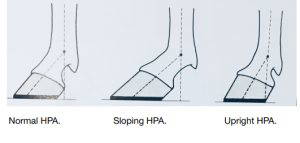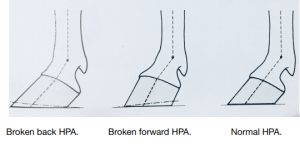The Importance Of Hoof Pastern Axis And Working Together To Achieve Good HPA The importance of the relationship between farriers, vets and horse owners to create part of the best possible team for a healthy, well maintained equine is unquestionable. As a professional farrier for over fifteen years I like to think that every vet and owner I work, on any case alongside, we all feel that we can openly air our opinions and listen to each other’s input and professional experience to come to the best possible solution to whatever possible problems we are dealing with when assisting an equine. Putting the expert opinions and experience together with the knowledge of the owner will undoubtedly give the best results in any situation.
When starting to understand the mechanical conformation of a horse and the way it moves it can be a mine field of hundreds of different areas of the horses body working in many different ways to simply allow the horse to take one stride forward. As professionals, we could be viewing the horse in a complex manner to build up a series of movements to hopefully determine the reason, for example, a horse is not sound or why it is experiencing limb interference. In early stages of horse assessment we would be accessing with only our knowledge and vision, with no assistance to build up a map of exact internal structure positioning.
Starting with Hoof Pastern Axis, in my opinion, is the most important rule in beginning to build a mechanical view of the horse’s limb. Horse owners may not all understand the basics of HPA and its complexity however I do think it’s hugely important for everybody to have a basic understanding of it and it’s simplicity.
The excess strain to a Deep Digital Flexor Tendon (DDFT) causing repetitive lameness could start to be investigated by determining the involvement of the HPA, or even poor lymphatic circulation due to incorrect positioning of parts of the build up of the limb can help to be understood by viewing the HPA and it’s correct or incorrect angles. It can affect extremely complex structures and their duties throughout the whole limb from toe to head movements. A HPA that is broken forward can cause excess concussion resulting in issues with every joint as high up as the shoulder and a broken back HPA can create a tightening of the DDFT which runs Palmer with the digit connecting centrally to the Distal Phalanx resulting in excessive wear to the navicular bone. HPA can also assist the owner into an understanding of simply why their farrier feels they need to support the heels with a slightly longer more supportive shoe or why their horse maybe stumbling on the first few strides after a jump which could start a limb investigation preventing the horse from long term damage such as an early onset of arthritis.
From reading this article I would like horse owners to achieve a simple understanding of correct and incorrect HPA and I would also like vets and farriers to understand the importance of horse owners knowing if their horses have issues with HPA and how we can all work together to help the equine achieve the best HPA possible for each individual case.
The Hoof Pastern Axis, when viewed laterally, is an imaginary straight line running from the centre of the fetlock, through the pastern, continuing straight from the coronet to the ground surface. The variations of HPA can be described in a few different simple ways.
A 48 – 55 degree angle in most cases is described as normal.
A 45 degree angle or less is thought to be sloping
A 60 degree angle or more is thought to be upright If the angle of the hoof and pastern are appearing to both be of the same angle then, although it can still have its complications, there is no break in axis and so therefore mechanically working with its relativity.
Broken Back HPA is when the angle is broken on the imaginary line running centrally from the fetlock through the pastern and breaking in angle from the coronet to the ground surface on a lateral view of the digit. For example the pastern is at a 55 degree angle and the hoof is at a 40 degree angle. Broken forward HPA is where the imaginary line running centrally from the fetlock through the pastern breaks in angle at the coronet to the ground surface on a lateral view of the digit. For example the pastern is at a 45 degree angle and the hoof is at a 60 degree angle.
Both broken back and broken forward HPA can usually be corrected short term, instantly, with correct trimming of the hoof and regular visits from the farrier. Maintaining the correct angles will in most cases result in the irradiation of a broken HPA. If the HPA is not improving after a period of 12-18 months with regular trimming then this will need further investigation with veterinary support to create an exact map internally to assist the correct procedure moving forward in such case.
In conclusion, Creating a trusted team around your horse with professionals that are open to discussing each other’s views and previous experiences and a responsible owner who will continue to carry out the procedures moving forward from a plan designed together for the best results for the equine, every individual will be one step ahead to assisting the best results for the future. Working together for the most amazing athlete, THE HORSE!
Written by Neil Turner DipWCF
Search
Recent Articles
- How to take a horse from SHOES to BAREFOOT with Alex Ridgeway & Dr Mark Caldwell
- 8 Laminitis Myths Busted!
- I’ve learnt as I’ve got older to really listen to what the people around me say about others
- The dangers of sleep deprivation in horses
- The third part of our series on stretching and flexibility with Sharon Stuart or Stuart Equine – forelimb and neck stretches for the horse and shoulder stretches for the rider
Categories
- Advice Hub
- Athlete
- Carriage Driving
- Dentistry
- Dressage
- Endurance
- Eventing
- Farrier
- Featured
- Featured Horse Ads
- Featured Posts
- Horse Racing
- Horse's Mouth
- Horseball
- Hunting
- Le Trec
- Leisure Riders
- Mounted Games
- Nutrition
- Polo
- Polocrosse
- Reining
- Rescue & Rehabilitation
- Show Jumping
- Showing
- Tack Room
- Team Chasing
- The Pony Club
- Therapy
- Training
- Vaulting
- Veterinary






